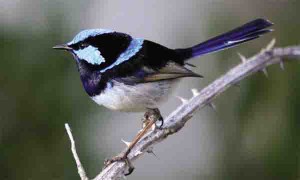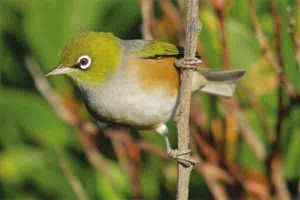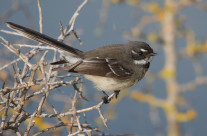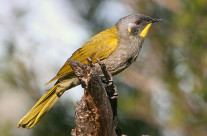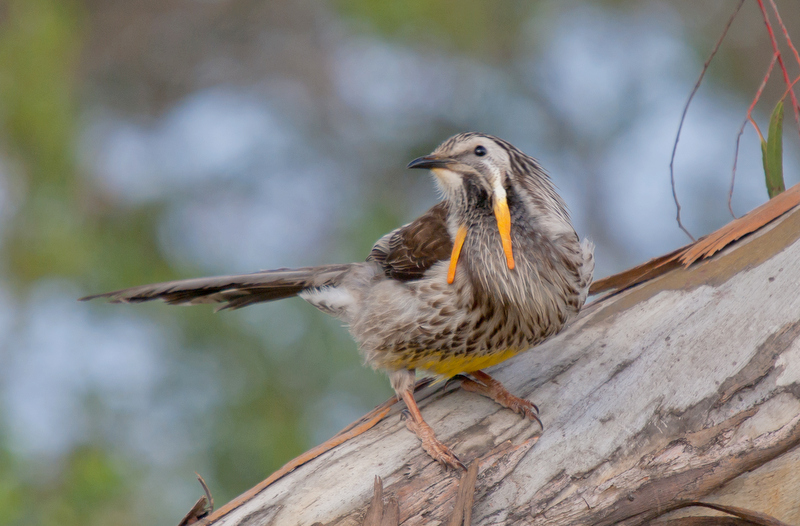It is possible to find any of these birds on the walking track. Some are migratory and only come here in the spring. Several species are vulnerable and protected. Tasmania has been isolated from the Australian mainland for about 10,000 years but it is a haven for a variety of birds, despite its relatively small size. The islands of the Bass Strait have allowed many birds to traverse between the mainland and the island state.
- There are about 200 pairs of the White-bellied Sea Eagle (Haliaeetus leucogaster) in Tasmania. The White-bellied Sea Eagle ( Haliaeetus leucogaster) has a wing span sometimes exceeding 2 m and a weight of up to 4.5 kg. On average each pair will produce less than one young per year (some have none, some two). Like all the birds of prey in Tasmania, this majestic creature is protected by law.
- There are 12 endemic species of birds in Tasmania and 3 have been identified in this area; Green Rosella ( Platycercus caledonicus), The well known Green Rosella ( Platycercus caledonicus ) is Australia’s largest rosella (330-370mm). Male and female birds have the same bright green and yellow colouring.
- Yellow Wattlebird ( Anthochaera paradoxa). The Yellow Wattlebird ( Anthochaera paradoxa) is Australia’s largest honeyeater (380-480 mm) and endemic to Tasmania, found in eucalypt forest and woodlands typical of the River-Forest. It feeds on insects and nectar. Both sexes are similar in appearance.
- Yellow-throated Honeyeater ( Lichenostomus flavicollis ). The Yellow-throated Honeyeater ( Lichenostomus flavicollis ) prefers a eucalypt forest habitat where it feeds on seasonally available nectar and insects. The species breeds from August to December, and lays two to three spotted pinkish eggs in a cup-shaped nest which is built within a metre of the ground.
- A variety of smaller birds dart and flitter about, chatter constantly, while attending to their feeding and nurturing needs on the River-Forest track. Some of these feisty, plucky, tenacious and courageous friends include the Silvereye ( Zosterops lateralis), The Silvereye ( Zosterops lateralis) is a bold little bird for its 12 cm size. It forages busily during the day with much calling and quick movement through the shrubbery.
- Grey Fantail (Rhipidura fuliginosa). The Grey Fantail ( Rhipidura fuliginosa) is around 17 cm in size. It is one of the friendliest birds in the bush and is named for its long fan like tail. It is characterized for its erratic flight and how it dashes out from its perch to chase insects.
- Superb Fairy-wren (Malurus cyaneus). The Superb Fairy-wren (Malurus cyaneus) is around 14 cm in size. It lives in small family groups and prefers habitats with dense cover and low shrubs. The male is a bright blue. Females and young birds are mostly brown above with a dull red-orange area around the eye and a brown bill.
- The Scarlet Robin ( Petroica boodang). These all range in size between 12cm and 17 cm and are insectivorous birds. The Scarlet Robin (Petroica boodang) is around 14 cm in size. It is territorial and monogamous. A pair will sit patiently on branches and then dives down to catch food. The male bird has a scarlet breast and the female bird is brown with a touch of red on her breast.
It is possible to find any of these birds listed below on the walking track. Some are migratory and only come here in the spring. Some are endemic (found only in Tasmania), some are not common and some are introduced. Several species are vulnerable and protected because their very survival is threatened. These are listed under the Tasmanian Threatened Species Protection Act 1995 and the Commonwealth Endangered Species Protection Act 1992.
Common birds here for most of the year (some are introduced)(E) = Endemic to Tasmania, (I) = Introduced Tasmanian Native-hen (Tribonyx mortierii) (E) Yellow-tailed black Cockatoo (Calyptorhynchus funereus) Green Rosella (Platycercus caledonicus) (E) Superb Fairy-wren (Malurus cyaneus) Spotted Pardalote (Pardalotus punctatus) Brown Thornbill (Acanthiza pusilla) Yellow-rumped Thornbill (Acanthiza chrysorrhoa) Yellow Wattlebird (Anthochaera paradox) (E) Little Wattlebird (Anthochaera chrysoptera) Yellow-throated Honeyeater (Lichenostomus flavicollis) (E) New Holland Honeyeater (Phylidonyris novaehollandiae) Crescent Honeyeater (Phylidonyris pyrrhoptera) Scarlet Robin (Petroica boodang) Flame Robin (Petroica phoenicea) Golden Whistler (Pachycephala pectoralis) Grey Shrike-thrush (Colluricincla harmonica) Grey Fantail (Rhipidura fuliginosa) Grey Butcherbird (Cracticus torquatus) Grey Currawong (Strepera versicolor) Forest Raven (Corvus tasmanicus) Common Starling (Sturnus vulgaris) (I) Silvereye (Zosterops lateralis) Welcome Swallow (Hirundo neoxena) Eastern Spinebill (Acanthorhynchus tenuirostris) European Goldfinch (Carduelis carduelis) (I) |
Birds that migrate and are only here from spring to autumnPallid cuckoo (Cuculus pallidus) Fan-tailed cuckoo (Cacomantis flabelliformis) (E) Striated pardalote (Pardalotus striatus) Dusky woodswallow (Artamus cyanopterus) (E) Black-faced cuckoo-shrike (Coracina novaehollandiae) (E) Picture Gallery provided by Alan Fletcher, Birds of Tasmania
|


